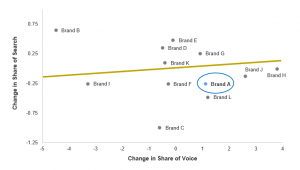Why creative testing must be part of brand tracking
Three marketing truths have emerged during the pandemic, and are highlighting the flaws of traditional brand tracking approaches. We discussed the first truth in a previous article, while this article addresses the second – the importance of testing creative, and why this should be included in brand tracking right now.
Media consumption might be in flux, yet global findings from Kantar’s CrossMedia work prove that long-held marketing truths remain intact: creative quality is the single largest driver of brand impact whilst reach, frequency and media synergy lag behind it.
In the early stages of COVID-19 back on March, we were asked repeatedly by clients whether pausing all advertising would be the ethical and the clever thing to do for the duration of the pandemic. But there’s never been a call for brands to stop advertising, with 76% of consumers remaining happy with the amount of advertising they see today.
In terms of content, we know that pre-crisis creative remains relevant and that scenes of a socialising nature still connect emotionally with consumers. Furthermore, the funny ‘ha-ha’ moments are sought after as antidotes, more actively in some markets than others. However, consumers now want more from brands’ messaging; they expect brands to articulate how they will help the community, and they observe and take note of the brands that partake in setting the new agenda, driving and guiding change.
The paradox here is that marketers underestimate the role of creativity and that consumers’ media opinion differs from that of marketers. On top of that, the pandemic has brought in a budget complexity: Kantar’s Global Business Compass reveals that three in four businesses have been negatively impacted by the crisis already and widespread budget cuts in marketing, communication and media have taken place.
Is this then the ideal time for a brand to ensure that their creative work strikes a chord and triggers the right emotional response with audiences? We argue that now, more than ever before, you should be asking yourselves whether your brand can be heard above the noise. Great creative drives profitable campaigns, with better testing being the holy grail to improve returns.
Getting the right information to maximise impact in a budget-conscious world
Let’s go back to our illustration of search pressure in my previous article and imagine the scenario where Brand A was below the yellow line having a high share of voice, but relatively low share of search. This would imply that your campaign needs attention, but where would you start looking for answers?

Using our in-market ad-testing tool, Ad Now, would be an excellent starting point to make smart and fast campaign investment decisions. This would allow you to define the creative strengths and weaknesses of each of your ads, find out whether the desirable target audience was reached, and establish how good the ROI is from your media investments. It also gives you a competitive edge as you can see what’s working (and not) for competitors. And all that across geographies for multi-media campaigns.
You might be reading this thinking that your objective is to cut budgets further, rather than to spend on ad testing. If that’s the case – how much can you cut until you reach a point of no visibility, and without jeopardising your brand’s future strength? Using our media to mind analytics app, you can simulate different spending scenarios to generate the acceptable levels of ad awareness for the short and long-term effects of your different media plans. The app cleverly isolates branded memories built over time for the short-term scenarios. The outcome? Informed and adjustable media spend decisions, serving as a thermostat to regulate awareness for now and the future.
Our advice to you is to keep on dreaming with ambition when most focus on mere survival. But don’t rely on a hunch; be guided by an informed mindset. Your marketing budget has possibly been reduced, and the marketing lever to pull has got to be the one that will release the desirable outcome. Test a real-world hypothesis between a marketing input and a target outcome, using marketing pressure analytics. And once that relationship is confirmed, we can help you simulate different future scenarios for the optimal marketing impact. Using AI-driven text to summarise relationships, our marketing pressure analytics app aligns and analyses different data sources that help you predict how your marketing actions will impact your KPIs.
Look out for the final article in this series, covering the third marketing truth that calls for a transformation in brand tracking, and the way you make decisions for your brand, in order to protect and grow during the pandemic. In the meantime, if you’d like to find out more about how Kantar’s brand guidance solutions can help you identify opportunities for your brand during the pandemic, please do get in touch.
This article first appeared in Kantar.com on November 27 2020.


